Category: Idaho National Guard
A small Idaho town makes a big Veteran’s Day impression
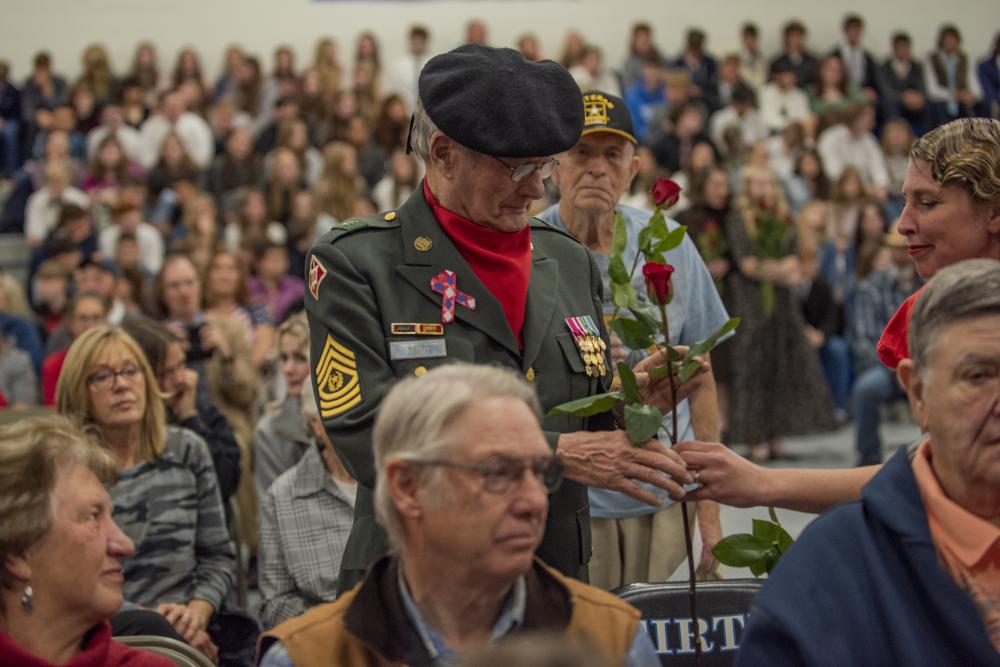
The rural town of Firth held a large Veteran’s Day assembly in Eastern Idaho on Nov. 10th, inviting hundreds of attendees, including Idaho’s adjutant general, Maj. Gen. Michael Garshak.
The assembly honored more than 100 local veterans and their families with help from more than 600 local and surrounding town volunteers, students, teachers and administrators. The assembly was held at Firth High School. The population of the small town is just shy of 600 people, according to the latest United States Census Bureau.
Four Soldiers from the Idaho National Guard’s 148th Field Artillery Regiment posted the flags. Local veterans of all branches and current service members were recognized at the assembly and presented with plaques and roses. Garshak spoke at the assembly about the importance of patriotism.
“Those of us in the military in Idaho are fortunate to serve in a state that truly honors and appreciates military service, and nowhere more so than here in Eastern Idaho,” said Garshak.
He continued. “While Veteran’s Day is an opportunity to thank those who have sacrificed, especially during times of war, where the survival of our nation has hung in the balance, it is also an opportunity to recognize and appreciate the value military service brings to our state, our country and to those who serve.”
Garshak thanked every veteran, past and present, and future veterans, for their service to our nation. He thanked the crowd for their support as well on behalf of the Idaho National Guard and the U.S. military.
Garshak closed his remarks with the takeaway that military service is not all about sacrifice.
“Yes, there are times when it is hard, but that comes with all walks of life,” he said. “I’ve learned that the things we value the most, and bring the greatest reward, are the things that we have worked the hardest for.”
Idaho Soldiers return home from overseas deployment
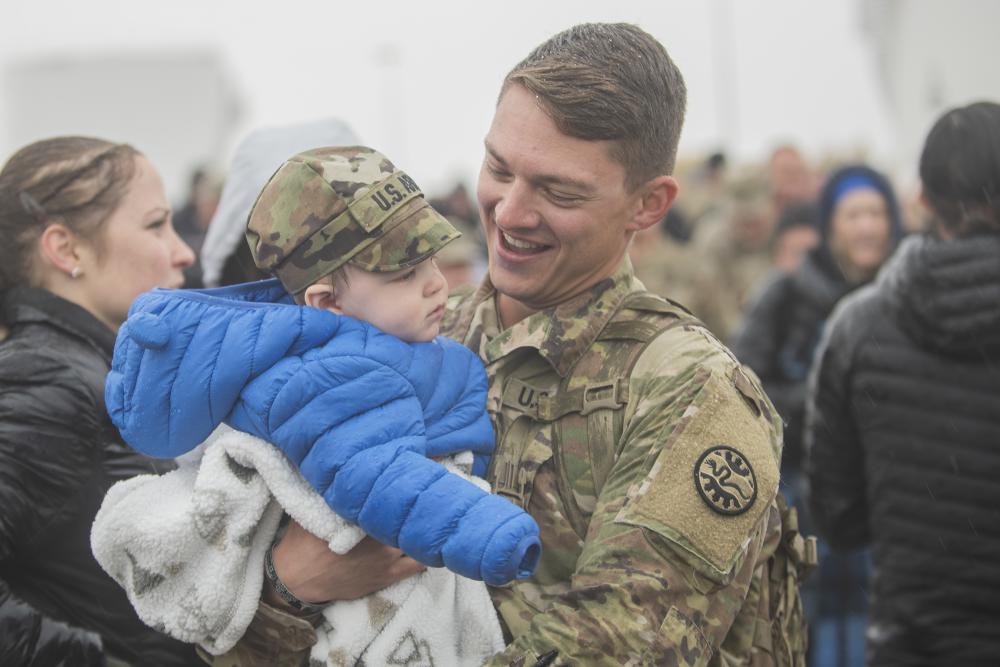
The Idaho Army National Guard welcomed home to Boise, Idaho, nearly 100 116th Cavalry Brigade Combat Team Soldiers on Nov. 4th after a yearlong deployment to Southwest Asia in support of Operation Spartan Shield. An additional 100 other Soldiers returned to their communities elsewhere across the state throughout the day.
“These Soldiers embody what the National Guard is all about: citizen-Soldiers who serve their nation when called upon and return home to their families and communities,” said Brig. Gen. Farin Schwartz, commander, Idaho Army National Guard. “It’s an honor to welcome these Soldiers home and I thank each one of them for their service and dedication to our state and nation. For 10 months, our Soldiers deterred enemy aggression in a very hostile environment, symbolizing our nation’s commitment to our global partners and allies.”
The Soldiers deployed in November 2021 to support the 116th Cavalry Brigade Combat Team’s Task Force Griz, which was headquartered by the Montana Army National Guard and included Soldiers from the Idaho, Montana, Florida and Nevada Army National Guards.
Idaho Soldiers comprised nearly 20 percent of the task force, which spent 10 months overseas, in addition to receiving 45 days of training stateside before deploying.
OSS is a joint mission under the United States Central Command and is part of Operation Enduring Freedom. The task force provided three mission response forces to the CENTCOM commander and conducted missions and training exercises in Iraq, Jordan, the Kingdom of Saudi Arabia, Kuwait, Syria and Qatar.
The task force conducted security and stability operations and demonstrated the U.S.’s continued commitment to deterring adversaries while supporting regional allies. The task force was relieved in October by another 116th CBCT-led task force, including more than 600 Idaho Soldiers, who are expected to return next year.
Task Force Griz Soldiers began returning to Fort Bliss, Texas, Oct. 24 and conducted demobilization activities before returning home.
The 116th CBCT previously deployed in support of the Global War on Terror in 2004 and 2010 to Iraq.
Boise firefighters train Idaho’s Civil Support Team on rope rescue
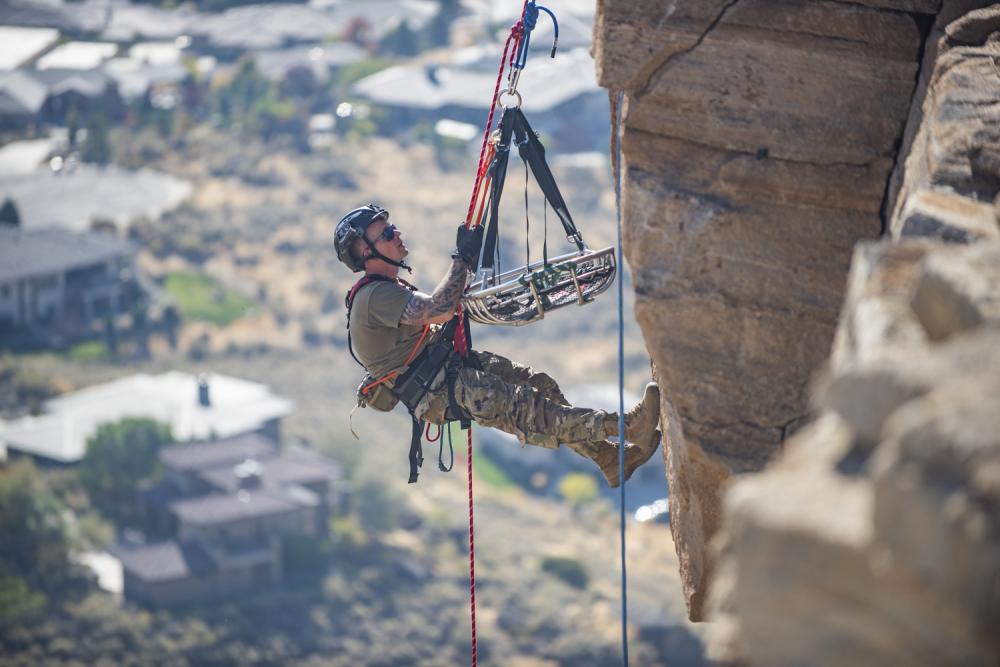
Throughout the month of October, the Idaho National Guard’s 101st Civil Support Team partnered with the Boise Fire Department Technical Rescue Team to participate in a ropes rescue course taught by Boise firefighters. The course, which served as an annual recertification for the CST Guardsmen, entailed two weeklong sessions for the 22-member team and helped the Boise firefighters refine their skills as trainers.
“This training benefits both the Idaho National Guard and us,” said Brent Matthews, captain of the Boise Technical Rescue Team. “Not only are we certifying our partners on ropes rescue training, but our instructors also get valuable experience and more proficient as certifiable instructors.”
The first week, Oct. 10th through the 14th, started with the classroom portion of learning about ropes rescue as a prerequisite for the hands-on portion of the training. Using what they learned about the ropes, the CST Guardsmen rappelled from tops of buildings at the Boise Fire Department’s Fire Training Center.
Once the Guardsmen were proficient at ropes rappelling, they practiced ropes rescues using wire rescue baskets at cliffs near the Table Rock trails in the Boise foothills to simulate a large-scale rescue of multiple people.
“To utilize the CST in ropes rescue, there would be an instance where something serious happened like a natural or man-made disaster or an emergency where the local search and rescue team wouldn’t have enough resources and could call us,” said Lt. Col. Robert Grimes, 101st CST commander.
The second weeklong training, Oct. 24th through 28th, focused on confined space rescues at Boise’s Lucky Peak Power Plant. The training mirrored a scenario where a devastated occurrence or a large-scaled catastrophe, like an earthquake, happened with severe damage to a building that could involve chemicals. This would require HAZMAT precautions, along with a large number of rescues in buildings with confined spaces, and would involve ropes and sked stretchers.
These incidents could be intensified by a lack of oxygen that is available in a non-ventilated area and complicated by the tight confines of the space, requiring rescuers to have air tanks during a rescue.
“Confined space is a rescue of people, for instance, inside of a building, in a tunnel or inside tanks where there could be a HAZMAT situation. They might be injured too badly to get out on their own or they could be unconscious,” said Grimes. “The CST has the capability to respond to weapons of mass destruction and HAZMAT scenarios already. The ropes rescue and confined space training adds another capability for the CST to assist the local fire departments and local agencies.”
The Boise Fire Department Technical Rescue Team is highly trained to handle the emergencies involving ropes rescues and confined space rescues, however, they could call upon their 101st CST partners if the large number of rescues surpassed their limit.
“We’ve been building this relationship and working together for quite a while,” said Matthews. “The CST has really great HAZMAT capabilities. Having the CST already trained at HAZMAT, plus the ropes rescue and confined space training, benefits us as well. In the future, I’d like to see us integrate more in real-world situations. When we have a HAZMAT call with confined spaces, we can call them to assist. I can see us working really closely together in the future.”
Idaho Army National Guard fires precision guided munitions
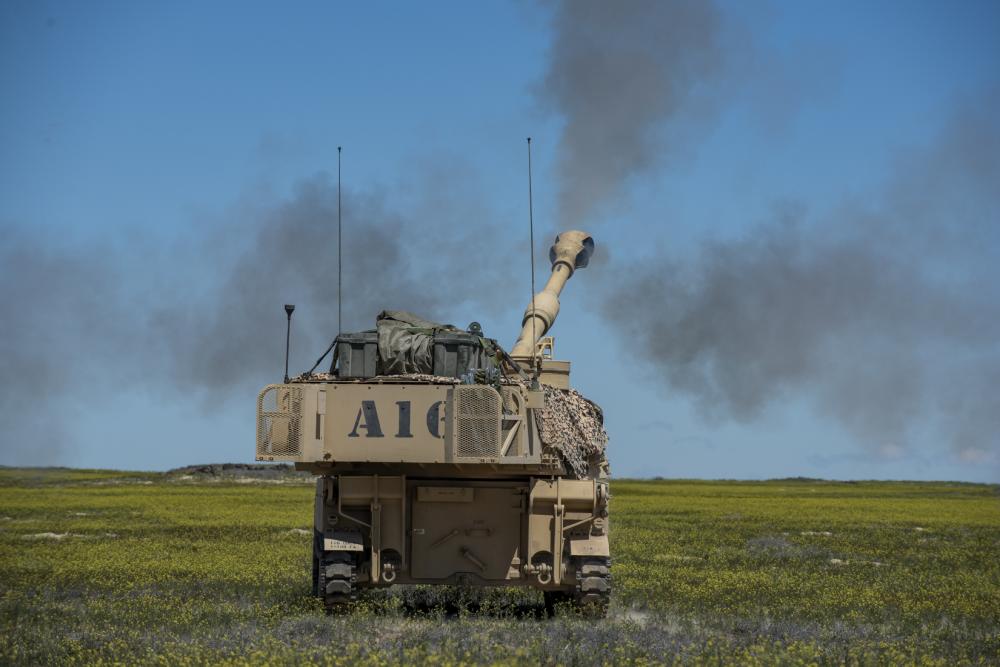
Crystal Farris/Idaho Military Division Public Affairs
The Idaho Army National Guard’s 1st of the 148th Field Artillery Regiment conducted its first-ever live fire training and certification using the U.S. Army’s modernized M1156 Precision Guidance Kit during the battalion’s annual training in the Orchard Combat Training Center May 12 to 27.
“The Idaho Army National Guard continues to receive and train on some of the military’s most modernized equipment so we can remain relevant and ready to defend our nation’s interest anywhere in the world,” said Brig. Gen. Farin Schwartz, commander of the Idaho Army National Guard. “The Idaho Army National Guard is one of the most modernized states in the Army National Guard, with equipment that enhances our capability to be interoperable with our active-duty peers.”
The modernized GPS guidance kit with fuze functions and integrated GPS receiver weigh three pounds and attach to existing 155mm artillery shells, converting them to smart weapons for improved target trajectory. Small aerodynamic fins on the fuze allow the system to make flight adjustments of the round’s trajectory and steer the shell on target.
This enables the 1-148th FAR to more precisely deploy munitions within 30 meters of an intended target, as opposed to the average 50 meters of traditional artillery, increasing the battalion’s lethality, while decreasing its spending costs, said Lt. Col. Brady Johnson, commander of the 1-148th FAR.
“Being PGK certified greatly increases the lethality of the field artillery battalion,” said Johnson. “The modernized weaponry allows 18 separate targets to be simultaneously targeted and attacked at a third the cost of conventional missions with minimal clearance of fire issues.”
Traditionally, the battalion would attack three enemy targets with a battery-sized element and six M109A6 Paladins, each firing three rounds of ammunition for a total of 18 rounds. Johnson said it costs approximately $20,000 for 18 rounds of conventional 155mm ammunition, which may or may not hit an intended target, whereas a PGK costs $6,500 per kit and will.
A fail safe can also prevent the shell from exploding if it falls outside 150 meters of an intended target, enabling Soldiers to more confidently call-in artillery support close to their position and reduce the possibility of collateral damage, said Sgt. 1st Class Mike Taylor, 1-148th FAR master gunner.
Soldiers first received training on the PGK when the battalion traveled to Camp Guernsey, Wyoming for annual training in July 2021 but were unable to conduct live fire with the precision guided munitions. Soldiers again received training on the PGK’s capabilities before conducting several live fire missions, first with conventional rounds and then with the PGKs.
Over 80 rounds were fired, including more than 50 PGKs, helping ensure the battalion’s ability to successfully perform its warfighting mission and certify using the modernized precision guided munitions.
“With the new technological advancements of today, it’s vital for us to be modernized,” said Taylor. “The 1-148th is really good at what we do, but with the new PGK, we are even better, hitting targets with every single round. This type of weaponry is going to be crucial on the current battlefield.”
The 1-148th FAR employs fire to destroy, neutralize, suppress or shape enemy forces; provides fire support to maneuver in close combat and during counterattack to control land areas; and provides counterfire.
It is equipped with the M109A6 Paladins that fire 155mm artillery shells. Crews that operate the Paladin consist of four-man teams; a driver, a number one man, a gunner and a section chief.
The number one man is responsible for loading and firing the weapon, the gunner fuzes the round and cuts propellant powder, while the section chief manages all firing data and ensures the weapon is laid on target.
MIA Soldier from Korean War identified and laid to rest in Idaho after 72 years
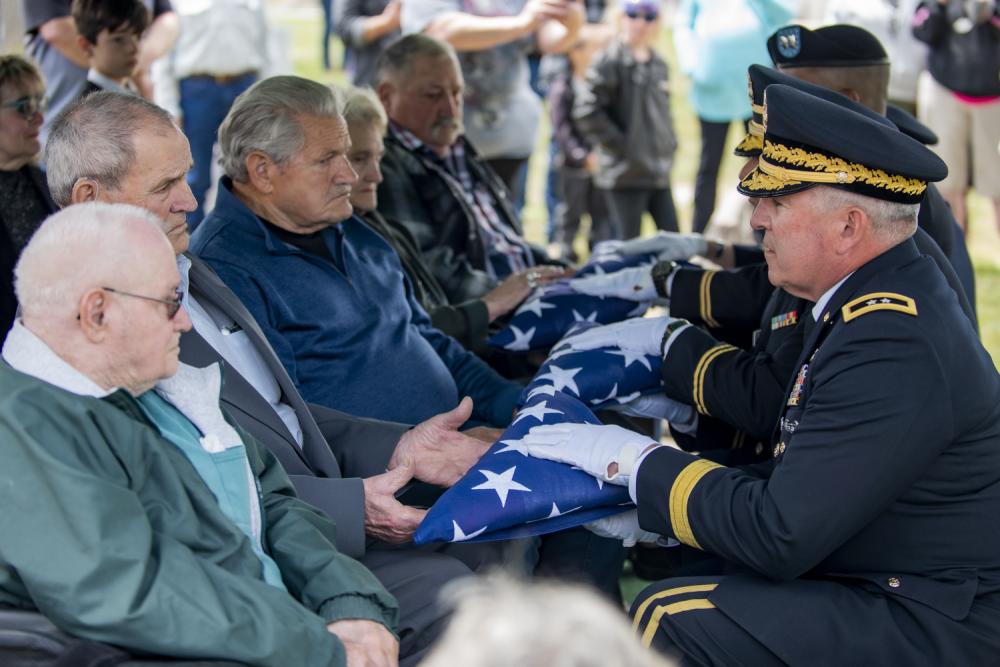
After 72 years, Pfc. Kenneth LeRoy Bridger was finally laid to rest and closure was given to his family during a full military honors graveside ceremony held in Twin Falls, Idaho, on May 21. Bridger was reported missing in action on Nov. 30, 1950, while serving alongside his fellow U.S. troops during the war against North Korea.
Bridger’s remains were identified on Jan. 26, 2022. Bridger was just 17 years old when he went missing and was a member of Company K, 3rd Battalion, 31st Infantry Regiment, 7th Infantry Division. He enlisted into the U.S. Army from Colville, Washington, but many of his remaining family resides in Idaho where he was laid to rest next to his brothers and his mother. Bridger’s four living siblings, along with their families, attended the private ceremony.
“Every U.S. service member is committed to never leave a fallen comrade behind. It is in our creed,” said Maj. Gen. Michael Garshak, Idaho’s adjutant general. “Although it has taken over 70 years to return Pfc. Bridger from the battle fields of Korea, it is comforting to me and to all who serve to know that we fight for a country that will never give up in keeping that promise. It is an immense honor to be a part of this ceremony and return Pfc. Bridger home to his final resting place with his family.”
Garshak presented Wilber Bridger, Pfc. Bridger’s brother and oldest surviving relative, the U.S. flag and the Purple Heart on his brother’s behalf. Bridger’s brothers Lynn and Halbert “Lee” Bridger along with his sister, Florence Fiscus, received the U.S. flag from the Idaho National Guard. The four siblings also received POW/MIA flags from the National League of the POW/MIA Families and local POW/MIA Awareness Associations in his honor.
Bridger was also awarded the Army Good Conduct medal, the National Defense Service Medal, the Korean Service Medal with three Bronze Service Stars, the Combat infantryman Badge, the United Nations Service Medal and the Republic of Korea-Korean War Service Medal.
The Idaho Army National Guard’s State Aviation Group performed a flyover with two UH-60 Black Hawk helicopters and the Idaho National Guard joint honor guard performed taps and the folding of the flag presentation.
Members of the Twin Falls community, lead by veterans, came together to honor and escort Bridger’s remains when they arrived to Idaho on May 17 in Twin Falls. According to the Defense POW/MIA Accounting Agency, Bridger was reported missing in action during the last night of his unit’s stand at the defensive perimeter south of the Pungnyuri Inlet on the east side of the Chosin Reservoir in North Korea.
Following an agreement between President Donald Trump and North Korean Supreme Leader Kim Jong-un, North Korea returned approximately 55 boxes containing the remains of U.S. service members on July 27, 2018. The remains were taken to Joint Base Pearl Harbor-Hickam, Hawaii, and entered into the DPAA laboratory for identification. One of the 55 boxes contained Bridger’s remains.
According to the DPAA, more than 7,600 Americans are still unaccounted for from the Korean War. Bridger’s name is recorded on the American Battle Monuments Commission’s Courts of the Missing at the National Memorial Cemetery of the Pacific in Honolulu, along with others who are still missing from the Korean War. A rosette will be placed next to his name to indicate he has been accounted for.
Idaho Army National Guard conducts joint medevac, casualty training

Crystal Farris/Idaho Military Division Public Affairs
Medics from the Idaho Army National Guard’s Headquarters and Headquarters Battery, 1st of the 148th Field Artillery Regiment conducted air medical evacuation and casualty treatment training alongside medical evacuation aviation assets at the Orchard Combat Training Center, May 17.
The training was supported by members of Detachment 1, Company Golf, 1st of the 168th General Support Aviation Battalion and several of its UH-60 Black Hawks, providing approximately 20 field artillery medics practice in air medevac scenarios while conducting their two-week annual training.
“I learned to stay calm and let the training I received in school take over,” said Spc. Regan Esplin, a 1-148th FAR medic. “I love being a medic, all the training that goes with it and everything about trauma medicine because it’s very immediate and the reward is you know how to save someone’s life. These kinds of experiences are crazy and not a lot of people get paid to treat casualties in a combat environment.”
For Esplin, the event was her first annual training with the battalion and a first opportunity to train with flight crews after graduating from the U.S. Army’s 68W Combat Medic Advanced Individual Training in 2021. During the event, she administered an IV and assisted other combat medics in stabilizing a patient.
During the training, combat medics had the opportunity to work with flight teams in loading patients into UH-60 Black Hawks, where they were evacuated from a point of injury to a Role 1 treatment facility. From there, medics offloaded patients from the aircraft and worked to evaluate, treat and stabilize them by administering tourniquets, IVs, ventilators and more prior to packaging them for transport to follow-on echelons of care.
“Training with medic and flight teams enable us to see how ready we are to respond to real-world situations and also make sure our newer medics get exposer to those situations in a tactical training environment first,” said Capt. David McDonald, a 1-148th FAR medical provider. “Depending on the situation, we may need to call in air medevac teams to transport our injured over long distances on the battlefield.”
In a tactical environment, the medical unit provides Role 1 care, which is the treatment a patient receives prior to surgical intervention, including self-aid, buddy-aid, tactical combat casualty care, tactical evacuation and medical evacuation, said McDonald.
When deployed in a tactical environment with the 116th Cavalry Brigade Combat Team, the battalion would coordinate the evacuation of patients to a Role 2 medical station, provided by the brigade’s Company Charlie, 145th Brigade Support Battalion. The Role 2 station offers surgeons, nurses, a pharmacy and short-term care.
1st Lt. Katherine Smith, executive officer with the medevac detachment, said its important combat medics receive training like this to become comfortable around aircraft in the likelihood they will have to work with them during a deployment. It’s equally important for members of her unit to train with combat medics so the two assets can ensure they understand each other’s operating procedures, she added.
“Different types of units that work together have to understand how the other operates,” said Smith. “In this case, the 1-148th combat medics need to understand how our pilots come into a landing zone and handoff a patient. What we need to know from them is at what point those medics need our assets to supplement that continuum of medical care.”
Idaho National Guard develops fiscal wellness through finance counseling

Crystal Farris/Idaho Military Division Public Affairs
Capt. Ashley Thropp, who serves as a behavioral health officer for the Idaho Army National Guard and a clinical social worker for the U.S. Department of Veterans Affairs, always knew how to earn money, budget and save.
She joined the military when she was 17, always lived below her means and ate bean and cheese burritos while earning her undergraduate degree because they were cheap and easy.
Although she still lives below her means now, it was only after having her son two years ago, that Thropp realized she didn’t understand the first thing about investing.
At that time, Thropp decided to meet with one of the Idaho National Guard’s financial counselors to learn ways to invest her money, set herself up for a better retirement and plan for her son’s future.
“I just had my son and was working from home at the time,” said Thropp. “My unit had put out information about free financial counseling and I wondered if the counselors could answer some questions about how my family could make better financial choices for our future.”
Financial counseling services
The Idaho National Guard’s financial counselors help with tax assistance, offer support and counseling opportunities for credit management and provide training in money management, budgeting and home buying. They also help service members in reaching long term goals, such as emergency savings, education, buying a house and retirement.
“Just like we need to see a medical professional for our annual check-ups, it’s a good idea to see a financial professional to ensure a financial fit future,” said Jennifer Wood, a personal finance counselor with the Idaho National Guard.
Statistically, Wood said financial issues are reported in the top three areas where service members struggle the most. Since a service member’s financial problems affect their military readiness, the Idaho National Guard provides free financial counseling and services through Accredited Financial Counselors, like Wood, who are available to all branches of the military, their family members, Gold Star families and veterans within 180 days of transitioning out of the military.
Initial financial appointments take approximately an hour and can be conducted in person, over the phone or by video conference. During that time, a financial counselor will get to know a person’s financial situation, gather information and develop a plan forward.
“Together we identify where they are and where they want to be financially in the future,” said Wood. “Setting future financial goals gives the client somewhere to allocate money. The goals are identified, labeled and achieved by monthly allocations.”
Making a return on her investment
During Thropp’s visit with the financial counselor, she said they discussed the five basic TSP funds, the Lifecycle funds and how Thropp felt about investment risk.
“The financial counselor talked me through each of the different TSP funds, how they work and about risk tolerance,” said Thropp. “I learned how choosing a different fund could mean I take more risk with my investment, but the gain is significantly better. She also helped me come up with some investment percentages that I was comfortable with and that made sense to me.”
After her meeting with the financial counselor, Thropp chose to move her TSP funds from the G fund to more aggressive C and S options. Thropp said she is pleased that her retirement investment grew after only several months.
The Thrift Savings Plan is the federal government’s sponsored retirement plan for employees, which all military service members are eligible for. Although she has been contributing 15 percent of her Guard earnings since 2005, Thropp never accessed or managed her money in the TSP and was therefore defaulted to the G option, which Wood describes as a glorified savings account.
“I didn’t understand risk tolerance and investing before meeting with the financial counselor,” said Thropp. “I didn’t understand the G fund only grew by very small percentages, compared to the C and S funds, which move with the market and have already grown significantly since I made the switch. I just wish I would have known about the benefits of contributing to different funds earlier.”
In addition to TSP investment opportunities, Thropp learned the importance of other investments, standalone mutual funds and investing in her children’s education through a 529 Education Account. The 529 account is an education investment account, offered in every state, that within Idaho also offers a state tax advantage.
Wood said the money in a 529 accrues much of the same way the TSP does, except it can only be used toward all qualified education expenses, including K-12 schooling and expenses such as tuition, books and school supplies.
“I learned that the 529 plan moves with the market and grows more over the years than it would through a savings account,” said Thropp. “The financial counselor showed me a graph of how the market has grown over the last hundred-year period. I opened mine last year, contributing $50 a paycheck in the market investment. So far, I’ve invested $1,750 of my own money and it’s already at $2,600.”
While different TSP options and a 529 were the best fit for Thropp, financial counselors are able to provide information and options to service members and their families based on individual needs.
All investments have risk, Wood said, and the amount of risk one is willing to take is the amount of return an investor should expect to see.
“Not everyone is in a position for a high-risk, high-reward investment,” said Wood. “That is why I recommend investing in mutual funds vs. stock instruments for beginning investors. I realize block chain currency, like Bitcoin, is a flashy and exciting way to invest, but it is also risky. I’ve seen service members who live paycheck to paycheck invest in cryptocurrency hoping to make a windfall return, only to lose money in the end. Investing slow and steady is the best way to gain wealth.”
For Thropp, she said her goal was to contribute as much as possible now toward her retirement, while she is still young and able to afford taking higher risks with her investments.
Grateful for Guard benefits
“In past years, I think I may have taken for granted the services and benefits we are offered as Guardsmen, like the free financial counseling,” said Thropp. “I can easily call or set up a video chat with a financial counselor. Other people don’t have that and when I look at it from that perspective, I realize how amazing it is to have these benefits at my fingertips and I try to share that knowledge with others.”
Thropp said she encourages other Guardsmen to invest in their TSPs and meet with a financial counselor about their retirement and investment opportunities to help prepare them for their futures.
“I pass that information on because I wish I would have known it myself early on,” said Thropp. “The Guard has so many opportunities and benefits available to us, if we only take advantage of it. I’m very grateful for the Guard and what it has provided me over the years to grow and improve my life both personally and professionally.”
Beside financial services, the Idaho National Guard’s Service Member and Family Support program also offers referral resources for crisis intervention, legal resources, TRICARE resources, emergency family assistance, community information and outreach and financial services.
Visit https://www.imd.idaho.gov/personal-finance-counseling/ and https://www.imd.idaho.gov/idaho-national-guard/family-programs/ for more information.
Idaho Army National Guard Soldiers prepare for deployment
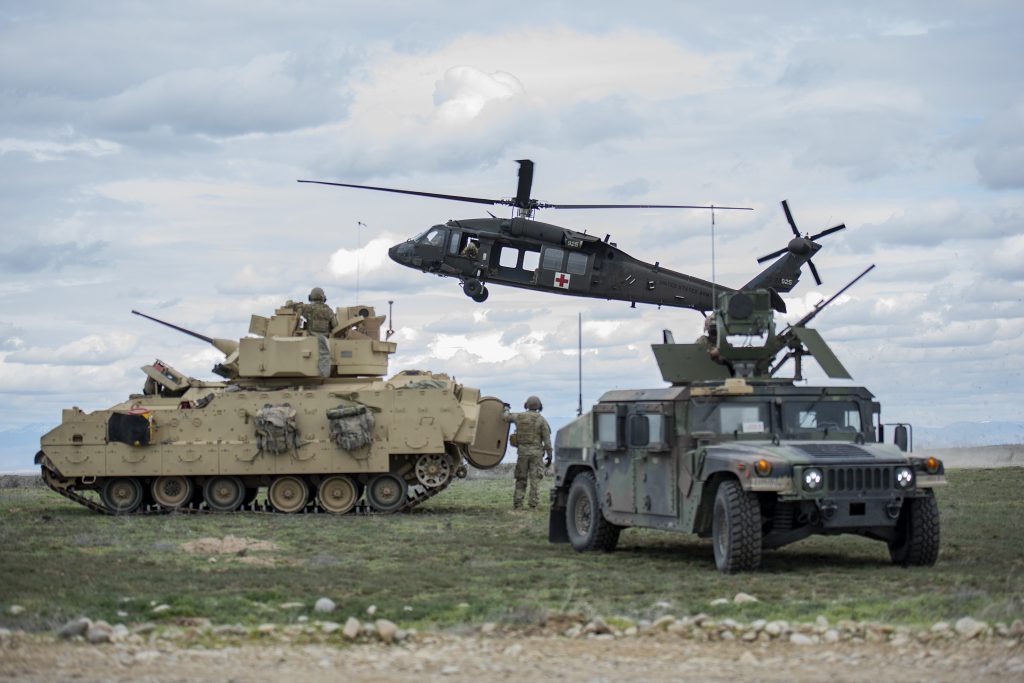
Maj. Robert Taylor/Idaho Military Division Public Affairs
The 2nd of the 116th Combined Arms Battalion conducted an extended drill period March 24 – April 1 at the Orchard Combat Training Center to build team proficiency prior to deploying in support of Operation Spartan Shield later this year.
“The battalion did a phenomenal job coming together as a team,” said Maj. Sam McDowell, 2-116th CAB commander.
M1A2 Abrams and M2A3 Bradley Fighting Vehicle crews conducted Table VI crew qualification tables and will build off their crew-level proficiencies to conduct platoon qualifications at annual training in May prior to mobilization and conducting a combined arms live-fire exercise at Fort Bliss, Texas.
The unit took advantage of several of the OCTC’s 23 training ranges to conduct individual weapon qualifications, crew-served weapon qualifications, a staff exercise, sniper training, Javelin firing and mortar training to Table III.
The battalion also teamed up with the Idaho Army National Guard’s 1st of the 183rd Assault Helicopter Battalion to conduct medevac and combat search and rescue training as well as air insertion missions on a simulated village located within the OCTC.
More than 700 116th Cavalry Brigade Combat Team Soldiers, comprising a task force led by the 2-116th CAB, will deploy to Southwest Asia for approximately 12 months in support of OSS later this year. OSS is a joint mission under the United States Central Command and is part of Operation Enduring Freedom.
The task force will relieve Task Force Griz, which is currently performing the same mission. Task Force Griz is led by the 116th CBCT’s 1st of the 163rd CAB and consists of Soldiers from the Idaho, Montana, Nevada and Oregon National Guards as well as augmentees from the Florida National Guard. More than 20 percent of the current task force is made up of Idaho Army National Guard Soldiers.
“The Soldiers of the 116th CBCT are training hard and will be prepared for this mission when they deploy,” said Lt. Col. Eric Orcutt, 116th CBCT commander.
The 116th Cavalry Brigade Combat Team previously deployed in support of the Global War on Terror in 2004 and 2010 to Iraq. Idaho National Guard personnel have been supporting the state of Idaho throughout the COVID-19 pandemic since 2020 and assisted the Idaho Department of Lands battle wildfires across the state last summer. Additionally, more than 400 Idaho Air National Guardsmen deployed to Southwest Asia in the summer of 2020.
Leveling up: Female Soldiers, Airmen serve in leadership positions across the Idaho National Guard
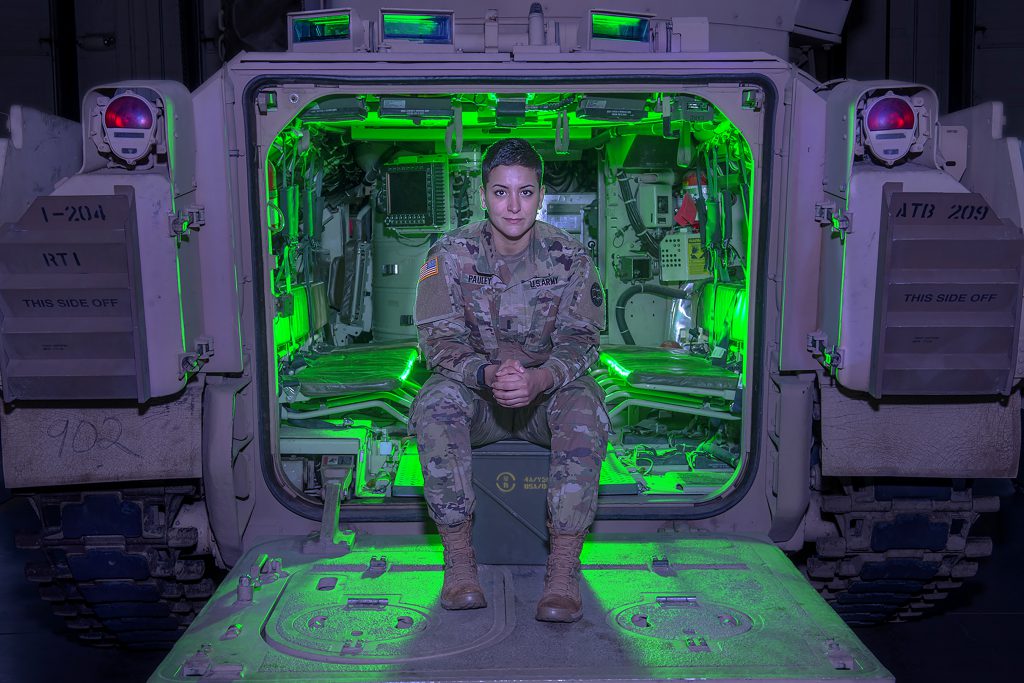
Maj. Robert Taylor/Idaho Military Division Public Affairs
Betty Corn became the first female to serve in the Idaho Air National Guard when she joined as a nurse in 1959. Female members wouldn’t enlist into the National Guard until 1968.
Since then, female citizen-Soldiers and Airmen have continued to blaze their own paths in the Idaho National Guard, even before the Army integrated females into combat-arms in 2015. Over the past decade alone, Idaho National Guardsmen have transitioned into career fields that were not previously opened to them or reached new heights in their profession while continuing to ensure the organization remains “Always Ready, Always There” to respond to emergencies at home or in defense of our national interest throughout the world.
In 2012, then Cpt. Nicole Smith, now Lt. Col. Nicole Washington, led more than a 100 Company A, 1-168th General Support Aviation Battalion Soldiers to Afghanistan for a year-long deployment, becoming the first female officer to lead an Idaho National Guard unit to combat as its senior officer.
In 2013, Chief Master Sgt. Tammy S. Ladley became the first female to serve as the 124th Fighter Wing’s senior enlisted member. The next year, Col. Sherrie McCandless became the first female to command the wing. McCandless now serves as the commanding general of the D.C. National Guard.
Also in 2014, Maj. Kimberly Tschepen became the state’s first female Soldier to command a battalion when she took command of the 145th Brigade Support Battalion and Command Sgt. Maj. Linda Burkhart became the state’s first female command sergeant major in 2015.
In 2015, Idaho Guardsman 1st Sgt. Erin Smith became the nation’s first female enlisted Soldier to graduate from M1 Armor Crewman School. Following her, Staff Sgt. Kylene Huerta completed the same course and became the first female Soldier to be assigned to the 116th Cavalry Brigade Combat Team as a tank crew member. In 2017, Sgt. 1st Class Melanie Galletti graduated from the U.S. Army’s Infantryman Course as the Idaho National Guard’s first qualified female enlisted infantry Soldier.
In 2017, Col. Lora Rainey was appointed as the state’s first female staff judge advocate.
In 2019, 2nd Lt. Brooke Berard and 2nd Lt. Lauren Bolt graduated from the U.S. Army’s Armor Basic Officer Leaders Course as the state’s first two female armor officers and 2nd Lt. Jessica Pauley became the state’s first female infantry officer.
Today, female Soldiers and Airmen proudly serve in leadership positions at every level of the Idaho National Guard, from the team level in the Army Guard to the group level in the Air Guard. In honor of women’s history month, we celebrate not only their accomplishments, but the fact that many of them are still writing their own history within our organization.
Female Soldiers and Airmen are trusted to lead their fellow Guardsmen. Soldiers like Sgt. Kaylee Bloxham, a combat engineer in charge of a Bradley Fighting Vehicle and its crew; and Airman like Chef Master Sgt. Kelly Bongiovi, who now serves as the senior enlisted member of the Idaho Air National Guard after she replaced Ladley as the 124th Fighter Wing’s command chief master sergeant.
On the officer side, 2nd Lt. Jessica Pauley, will lead an infantry platoon of infantry on a deployment later this year and Col. Elizabeth Sumner, the highest-ranking female in the Idaho National Guard, leads more than 340 Airmen as the 124th Mission Support Group commander.
Sgt. Kaylee Bloxham
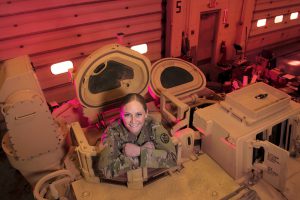 Sgt. Kaylee Bloxham didn’t set out to be the Idaho Army National Guard’s first female 12B combat engineer. It’s a feat she didn’t realize she had accomplished until after she graduated from the required reclassification course.
Sgt. Kaylee Bloxham didn’t set out to be the Idaho Army National Guard’s first female 12B combat engineer. It’s a feat she didn’t realize she had accomplished until after she graduated from the required reclassification course.
She was only looking to serve her country and follow in her older sister’s footsteps when she enlisted into the Idaho Army National Guard in 2006 as a military police Soldier. She reclassed after the 116th Brigade Special Troops Battalion transitioned to the 116th Brigade Engineer Battalion in 2016 and the unit eliminated its MP platoon.
Bloxham chose to become a combat engineer after observing engineers train on C4 demolition during annual training. However, she’s been assigned to a Bradley Fighting Vehicle for the past six years and has yet to complete demolition training herself since reclassing.
“I didn’t like the Bradley at first,” she said. “I didn’t know how it functioned, but now that I’ve been on it for a while and know how it functions, I really like it.”
Bloxham is a vehicle commander in A Company, 116th Brigade Engineer Battalion.
“Not only am I responsible for myself, I’m responsible for two others,” she said.
As a vehicle commander, she is also responsible for a 30-ton armored vehicle equipped with three weapon systems and its gunner and driver. She’s responsible for helping the driver maintain situational awareness in a vehicle with large blind spots and identifying and confirming enemy targets before giving the gunner the command of execution to fire.
“It’s fun,” she said.
She said she loves being able to lead and train her crew as a part-time member of the Idaho National Guard. When she’s not training, she also works as a parts specialist for High Desert Bobcat in Twin Falls.
Staff Sgt. Antonia Lemos
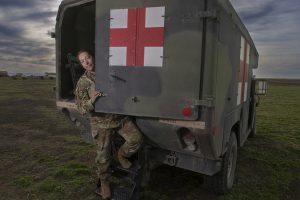 Staff Sgt. Antonia Lemos always knew she wanted to work in the medical profession when she was a kid. She never became a doctor because she didn’t finish college, but by enlisting into the Idaho Army National Guard, she was able to become a 68W combat medic and still have a career in the medical profession.
Staff Sgt. Antonia Lemos always knew she wanted to work in the medical profession when she was a kid. She never became a doctor because she didn’t finish college, but by enlisting into the Idaho Army National Guard, she was able to become a 68W combat medic and still have a career in the medical profession.
“I very much love being a medic,” she said. “As a medic, I am able to do a lot of the things I always wanted to do: help those who are hurt and see interesting wounds.”
Lemos enlisted into the Idaho Army National Guard in 2003. At the time, she was 20 and the single mother of two children. She said she was working fast food and retail and said she didn’t have a lot of direction or self-discipline to finish her education.
“As a single mom, it’s really hard,” she said. “Anything that would benefit my situation for my kids was a good thing and the National Guard looked like an avenue that would provide that, and in the end, it did.”
Lemos liked that she could join the military while raising her kids around her family. She was able to purchase a house by herself using a Veteran Affairs loan. She also found full-time employment as the Idaho Army National Guard’s drug testing coordinator, which interfered with plans to finish college, but she didn’t want to pass up the chance to be able to provide for her family.
Lemos is currently the emergency care sergeant for Headquarters and Headquarters Company, 2-116th Combined Arms Battalion. She was the first female Soldier organically assigned to the battalion when the Army started integrating females into combat-arms units in 2015.
She is a squad leader and assigned as the medic in charge of the battalion’s aid station. As a squad leader, she is in charge of eight Soldiers.
“At this point, I’ve been in long enough where I got to be that young Soldier and now, I’m mentoring young Soldiers,” she said. “Watching Soldiers grow is my favorite part of the job.”
Lemos said she tries to emulate good leadership for her Soldiers, which comes from good mentorship.
“Mentorship comes from above, below and side-to-side, it’s the full 360,” she said.
In addition to watching Soldiers grow, she enjoys being able to assist Soldiers who need additional resources in her role as the Idaho Army National Guard’s drug testing coordinator.
“My favorite part of being an NCO is finding someone who needs help and giving them the resources they need to hopefully be successful, not necessarily in the Guard, but in life,” Lemos said.
Lemos’s father, brother and uncle have also served National Guard.
Sgt. 1st Class Jessica Rice
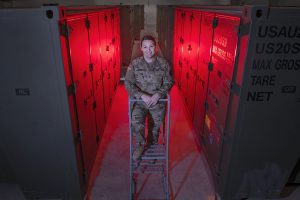 Sgt. 1st Class Jessica Rice has two jobs in the Idaho Army National Guard. During the week, she’s the accountable officer for the 116th Cavalry Brigade Combat Team’s Supply-Support Activity and during drill weekend, she’s a platoon sergeant for A Company, 145th Brigade Support Battalion.
Sgt. 1st Class Jessica Rice has two jobs in the Idaho Army National Guard. During the week, she’s the accountable officer for the 116th Cavalry Brigade Combat Team’s Supply-Support Activity and during drill weekend, she’s a platoon sergeant for A Company, 145th Brigade Support Battalion.
“I love it,” she said. “I’m responsible for training Soldiers. I get to teach them all the things I’ve learned in my 18 years and hopefully make them better than I am.”
As the accountable officer, she supervises seven Soldiers in the epicenter of logistics. The SSA provides a critical link between the brigade’s supply echelons and the national supply chain to ensure rapid fielding of repair parts, which drastically cuts down on the amount of time the brigade’s vehicles are down for maintenance issues.
Rice has supervised the SSA since it was established last year, a position typically held by a warrant officer. Only 11 National Guard states have an SSA.
Rice joined the Idaho Army National Guard after her first semester of college to help pay for her education. She ended up finding full-time employment in the organization before she could finish her degree. She’s been assigned to units in Boise and Burley as well as Lewiston and Post Falls multiple times.
“Throughout my time in the Guard, I’ve had six moves in 10 years,” she said. “Every time I’ve gone to a new unit, I’m instantly family. It doesn’t matter what I’m going through in my life, I have a dozen Soldiers who I could call at they’d be at my doorstep, and it wouldn’t matter why.”
At drill, Rice’s platoon of 22 Soldiers is responsible for distributing the brigade’s Class I (food, rations and water), V (Ammunition) and IX (repair parts) supplies.
As a leader, Rice said communication with her Soldiers is important.
“Make sure what you’re saying is what they are hearing,” she said.
1st Sgt. Lisa Carlin
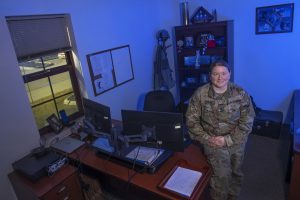 1st Sgt. Lisa Carlin remembers watching “Courage Under Fire” when she was 12 and knowing she wanted to join the military.
1st Sgt. Lisa Carlin remembers watching “Courage Under Fire” when she was 12 and knowing she wanted to join the military.
A few months after graduating high school, she enlisted into the Idaho Army National Guard in 2003 as a 15P aviation operations specialist. Unlike Meg Ryan’s character, she didn’t want to fly because she gets air sick. Aviation operation specialists support aviators from the ground and plan tactical missions.
Nearly two decades later, she is the first sergeant of 1-183rd Assault Helicopter Battalion’s Headquarters and Headquarters Company. As first sergeant, she is responsible for the health and welfare of more than 80 Soldiers.
“It’s all about taking care of Soldiers,” she said. “Regardless of what they have going on, they are the ones doing all the actual heavy lifting. If they aren’t getting taking care of, nothing else will get done.”
Carlin said she chose to join the Idaho Army National Guard over the U.S. Army because she wanted to remain close to home and pursue a college education.
“I already had friends and a support system here,” she said. “The idea of sticking around them seemed more appealing than uprooting every three years.”
Not only was Carlin able to remain close to her friends and family, but she has also made new friends over the years who feel like family.
“I like working with the same group of people throughout my career,” she said. “It builds a family mentality. You get to know them outside of work as well and become lifelong friends.”
The Idaho National Guard also gave Carlin the chance to serve with her actual family. Her sister is a security forces supervisor in the 124th Fighter Wing.
Carlin has been a member of the National Guard’s Active Guard/Reserve program since 2004. She’s served in multiple leadership positions in HHC before becoming its first sergeant. Currently, her readiness noncommissioned officer, Sgt. Kaitlyn Nicolosi, and training specialist, Spc. Jordyn Harris, are also female Soldiers entrusted with key company positions.
“Gender doesn’t play a role,” Carlin said. “It’s been my experience whoever does the job best gets the job.”
Chef Master Sgt. Kelly Bongiovi
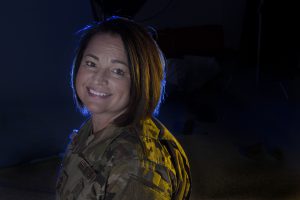 Chief Master Sgt. Kelly Bongiovi enlisted into the Idaho Air National Guard to provide a better life for her family. What she found was a career that has spanned more than three decades and led to her becoming the organization’s senior enlisted leader.
Chief Master Sgt. Kelly Bongiovi enlisted into the Idaho Air National Guard to provide a better life for her family. What she found was a career that has spanned more than three decades and led to her becoming the organization’s senior enlisted leader.
Bongiovi currently serves as the Idaho Air National Guard’s state command chief. By position, she is one of the Idaho National Guard’s most senior enlisted female members and she is the first female Airman to serve as the senior enlisted leader to the commander of the Idaho Air National Guard.
“I never planned on staying in the Air Guard this long,” she said. “I didn’t think they’d want met his long.”
Bongiovi enlisted in August 1991. She spent most of her career working nearly every logistic position in the 124th Fighter Wing before becoming the wing’s command chief in 2018. Over the years, the wing’s mission has changed from flying F-4s to flying A-10 Thunderbolt IIs and C-130s to only the A-10 mission. The logistics squadron’s name has also changed over that time, but Bongiovi’s work ethic has remained consistent.
“I was never in it to make a stripe,” she said. “I was always going to work my hardest and whatever came, came. I figured if I do good things, good things would happen. I just worked really hard and good things happened.”
Bongiovi decided to enlist shortly after tragically losing a child at birth. At the time, she was working in retail and the loss caused her to take a hard look at the life she would have been able to provide her child.
Several of her co-workers were members of the Idaho Air National Guard and told her about the many benefits they received as Guardsmen. Desert Storm was happening around the same time. Another co-worker’s husband deployed in support of the Gulf War but never made it home.
“I knew after I lost my kid, I needed to change my life,” she said. “I just had this passion of what I could do differently in the world to make a difference, not only for myself, but what I could do differently for my family. I also felt very passionate about what was going on in the world. I felt like I needed to join.”
Bongiovi said the biggest change she’s seen over the years is the seriousness of the National Guard’s mission and its increased operations tempo as the Guard became an operational reserve in the aftermath of 9/11. Bongiovi herself has deployed more than a half-dozen times in support of operations around the world.
Bongiovi has no question she was able to build a better life for her family since joining the Air Guard. She credits the support system she found through her fellow Guardsmen and the organization’s vast family resources as reasons why. In addition, she’s worked full time for the Idaho Air National Guard for the past 23 years and met her current husband through her military service.
Her husband, Hal, retired in 2020. He also served as the Idaho Air National Guard’s senior enlisted leader before advancing to the highest enlisted position in the Idaho National Guard as the state’s senior enlisted leader. Their oldest son is currently an A-10 Thunderbolt II crew chief in the 124th Fighter Wing and their youngest son is heavily involved in the organization’s family programs.
“You can pick yourself up when you have to and you can make yourself better,” she said, looking back on the path she’s taken since enlisting 31 years ago.
As the Idaho Air National Guard’s senior enlisted leader, she advises the commander of the Idaho Air National Guard, currently Brig. Gen. Tim Donnellan, on all enlisted matters. She said she doesn’t see the results of her work every single day like she could when she could physically watch A-10s take off and land on the flight line, but that the accomplishments feel much bigger when they do happen, however long they take.
She currently serves on the Air National Guard’s Enlisted Field Advisory Council. The committee works on proposed changes to policies and laws that impact Airmen across the force.
“When you see a policy go through that you’ve been working on for a year and it finally gets through the system and it’s going to make a change to thousands of Airmen, that’s a huge accomplishment,” she said. “It feels good knowing you’re going to help someone down the road.”
Bongiovi says she feels very privileged to serve in her current position but doesn’t dwell on being the first female Airmen to hold the position.
“I always try to help people,” she said. “I always tell Airmen to never miss an opportunity to learn no matter where they are in their careers. Look for something to work on and go work on it.”
In addition to looking for ways to improve, Bongiovi recommends having three people to confide in. She says have someone to tell the good, the bad and the ugly to, describing the good as the good things that happen; the bad things that happen; and someone who can help problem solve when necessary.
“The further you go up in the chain, the lonelier it gets,” she said. “You need people you can confide in when you start climbing the chain.”
Chief Warrant Officer 2 Kira Tank
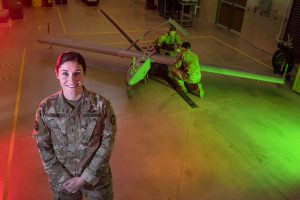 Chief Warrant Officer 2 Kira Tank is a dual-status federal technician, which means she has two jobs in the Idaho Army National Guard. During the week, she is the unmanned aerial systems supervisor for D Company, 116th Brigade Engineer Battalion. During drill weekend, she serves as the company’s operations officer and will become an instructor at the state’s Warrant Officer Candidate School next month.
Chief Warrant Officer 2 Kira Tank is a dual-status federal technician, which means she has two jobs in the Idaho Army National Guard. During the week, she is the unmanned aerial systems supervisor for D Company, 116th Brigade Engineer Battalion. During drill weekend, she serves as the company’s operations officer and will become an instructor at the state’s Warrant Officer Candidate School next month.
“I want to give back,” she said of her new position. “I’ve had a lot of excellent mentors and I think I can do that for other individuals and shape the future of the warrant officer cohort.”
Tank has served in the Idaho Army National Guard for the past 13 years. She began her career as an UAV operator before becoming a maintainer. She deployed with the 116th Cavalry Brigade Combat Team in 2010 in support of Operation New Dawn.
Upon returning from the deployment, she met then Chief Warrant Officer 3 George Tomlinson, who was assigned as the UAS platoon leader. She said she didn’t know much about warrant officers then, but Tomlinson mentored her and Jacob Stavenau and developed them professionally, which led to both Soldiers becoming warrant officers. Tomlinson now serves as the state command chief warrant officer.
As an enlisted member, Tank flew more than 350 UAV missions and reached the rank of staff sergeant before becoming a warrant officer.
“I love being able to bridge the gap between officers and the NCO corps,” she said. “Warrant officers are a very trusted profession. We’re subject matter experts. Officers rotate positions often and they lean heavily on us. They have to be able to trust us to give them the best advice.”
Tank said she joined the Idaho Army National Guard because she wasn’t sure what she wanted to do with her life, but she felt like the military was something she’d be good at. She said she’s made it a career because she really enjoys the comradery she’s found.
As the UAS supervisor, she oversees a team of eight Soldiers and coordinates missions for the company’s Shadow.
“We just have really great hard-working people who are held to a higher standard than their rank,” she said. “They have a lot of the same training and qualifications pilots do.”
She’ll take the lessons she’s learned from the past 13 years to her new position and use them to develop future leaders.
“Being a leader and a mentor is super important to me,” Tank said. “I’ll be able to play a key part in a pivotal point in someone’s career and be someone they can reach back to if they have questions.”
2nd Lt. Elizabeth Horan
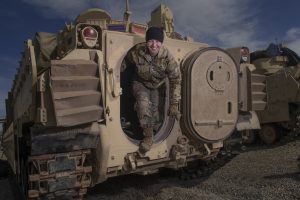 2nd Lt. Elizabeth Horan is a platoon leader for A Company, 116th Brigade Engineer Battalion. As a platoon leader, she leads three dozen 12B combat engineer Soldiers on the battlefield.
2nd Lt. Elizabeth Horan is a platoon leader for A Company, 116th Brigade Engineer Battalion. As a platoon leader, she leads three dozen 12B combat engineer Soldiers on the battlefield.
She joined the Idaho Army National Guard in 2017 as a 15D aircraft powertrain repairer and then earned her commission through BYU-Idaho’s ROTC program in 2020.
“I wanted to serve and to know that I contributed a little bit,” she said. “Plus, it’s fun.”
As a platoon leader, Horan said her job is making sure the platoon’s equipment is taken care of and that her Soldiers’ needs are met, in addition to making critical leadership decisions.
Combat engineers work to provide the maneuver commander with mobility, counter-mobility and survivability support, including detecting and clearing minefields and placing and detonating explosives. A Company uses Bradley Fighting Vehicles to provide engineer support to the 116th Cavalry Brigade Combat Team’s three combined arms battalions.
Horan said she enjoys getting to work with a Bradley crew and training with demolitions. As one of the Army’s junior officers, she relies on her platoon’s NCOs to help mentor her as she gains relevant experience in her career field.
“There’s a wealth of knowledge there,” she said. “A lot of those guys have been there for years and they are so willing to share what they know. It makes it fun to spend time with them on the Bradley and just do different things.”
As a platoon leader, she enjoys working with her Soldiers before she’ll take on additional administrative duties as she moves up in rank.
“Be willing to get dirty, get in and work hard next to your Soldiers,” she said. “Don’t try to excuse yourself from anything.”
1st Lt. Jessica Pauley
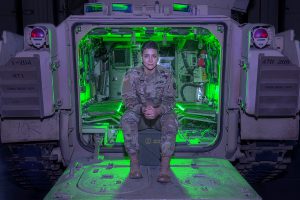 1st Lt. Jessica Pauley is thankful for the females who served before her.
1st Lt. Jessica Pauley is thankful for the females who served before her.
“They paved the way and without them, we wouldn’t be here,” she said.
As the first female infantry officer in the Idaho Army National Guard, Pauley helped paved the way for future female infantry Soldiers to serve in the 2-116th Combined Arms Battalion, but it’s a position she probably wouldn’t have sought out if she hadn’t been encouraged to do so by Sgt. 1st Class Melanie Galletti.
Galletti was the state’s first enlisted female Soldier to become 11B infantry qualified in April 2017. As part of the Army’s initiative to integrate females into combat arms positions, units were required to have a branch qualified female officer and a noncommissioned officer in place before new female recruits could be assigned to the unit.
Pauley knew that by becoming an infantry officer, along with Gelletti, she would pave the way for females to serve in the unit. Since then, several females have served in the state’s only infantry company, but Pauley is currently the only female assigned to the unit.
She’s a platoon leader for C Company, 2-116th Combined Arms Battalion. She oversees four Bradley Fighting Vehicle crews, including her own, and three squads of dismounted infantry Soldiers.
“It’s exactly the stuff people generally join the Army to do,” she said. “We shoot, we do squad and platoon exercises and there’s lots of hands-on training, including demolitions.”
Pauley said the hours are long, but the job is fun. She trains yearlong to be able to meet the physical demands of the job.
“It’s part of my job to be as physically fit as I can be,” she said. “If it comes down to it, Soldiers expect that from me and I expect that from them. Just like I’d expect any of my Soldiers to be able to pull a fully kitted Soldier out of a Bradley Fighting Vehicle while under fire. It’s dangerous if they can’t do it. It’s dangerous if I can’t do it as well.”
Pauley enlisted into the Idaho Army National Guard on her 23rd birthday in 2014. She served as a public affairs specialist before enrolling into the Boise State University ROTC program for her final two years of college. She said getting school paid for and getting paid to go to school seemed like a really good idea.
“It’s a good opportunity for everyone,” Pauley said. “It’s a relatively small commitment and you get the benefits of giving back to your country.”
Pauley has spent most of her career as a part-time Soldier and is looking forward to deploying with the 2-116th Combined Arms Battalion later this year so that she can spend additional time with her platoon.
“I’m excited for the opportunity to get some quality time with my platoon and train,” she said. “When we only see our Soldiers one weekend a month and a few weeks in the summer, there’s only a certain level of proficiency you can hit with that amount of time. We will have the chance to train every day and set some things in stone for Charlie Company that will last longer than our time in the unit.”
Pauley earned her commission in 2018 and attended the US Army’s Infantry Basic Officer Leaders Course in June 2019.
“The entire experience is a learning experience from the moment you swear in,” she said. “You’re faced with challenging situations, and you have to learn as much as you can from each one.”
As she’s grown throughout her time in the Army National Guard, she’s also thankful for those who have mentored her along the way.
“The commanders and first sergeants I’ve had the honor and privilege of serving with have taught me so much and they care so much about Soldiers,” she said. “It’s really inspirational.”
Capt. Haily Barley
 Capt. Haily Barley serves as the commander of Headquarters and Headquarters Company, 2-116th Combined Arms Battalion. She initially commissioned as a signal officer after graduating from the University of Idaho’s ROTC program but rebranched as an armor officer to be closer to the fight on the ground.
Capt. Haily Barley serves as the commander of Headquarters and Headquarters Company, 2-116th Combined Arms Battalion. She initially commissioned as a signal officer after graduating from the University of Idaho’s ROTC program but rebranched as an armor officer to be closer to the fight on the ground.
“I loved the signal community,” she said. “But at the end of the day, I’m just more comfortable and confident in this role, especially with my civilian career. I love it. You’re fighting the fight and have to make decisions more quickly.”
Barley served as a platoon leader and executive officer in the battalion before assuming command of its headquarters unit. As the commander, she is responsible for more than 180 Soldiers and ensures the battalion’s scouts, mortars, snipers, medics and staff are ready to execute their missions when called upon.
“The biggest part is just taking care of your Soldiers, wholeheartedly and leading from the front,” Barley said. “If they are not taken care of, then you don’t have a fight.”
The battalion is scheduled to deploy later this summer.
“I’m excited, but it’s bittersweet,” she said. “Now that I have kids, it’s a little rough, but it’s pretty much the reason you join.”
In addition to serving in the Idaho Army National Guard, Barley is a patrol deputy for the Canyon County Sheriff’s Office.
“Don’t be afraid to make decisions,” Barley said. “Someone might think you’re being bossy or bitchy, but you’re just trying to get your job done. Don’t be afraid to take the reins and learn or fail.”
Maj. Kristin Daigle
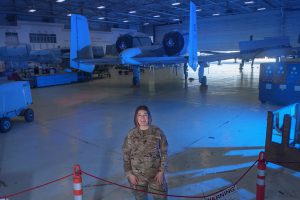 Maj. Kristin Daigle enlisted into the Idaho Air National Guard in 2004 to help pay for college.
Maj. Kristin Daigle enlisted into the Idaho Air National Guard in 2004 to help pay for college.
She attended college at Boise State University without having to take out any student loans and found full time employment within the 124th Fighter Wing shortly after graduation. With her degree, she was also able to commission as an intelligence officer.
“I always wanted to be an officer,” she said. “The timing seemed right.”
Daigle was hired to be an instructor for the wing’s Intelligence Formal Training Unit after spending seven years as an enlisted intelligence analyst. She also worked as the wing’s sexual assault response coordinator and as the executive officer for the Idaho Air National Guard.
Today, she’s the commander of the 124th Fighter Wing’s Maintenance Operations Flight, a position she sought for increased leadership responsibilities.
“Best decision I ever made,” she said. “I love being in maintenance!”
The flight is responsible for the long-range management of the wing’s A-10 Thunderbolt II aircraft and manages aircraft maintenance to meet operational requirements for the 190th Fighter Squadron.
“There are different challenges presented every day,” she said. “There’s always something breaking and you have to figure out how to fix it and still meet the wing’s flying schedule.”
The flight consists of five shops and more than 20 Airmen. Daigle has been in command of the flight since 2019.
“It’s given me an appreciation for everyone’s different perspectives that they bring to the job and I try to balance the mission requirements with making sure the people are taking care of,” she said.
Lt. Col. Christina Taylor
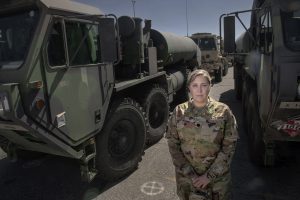 Lt. Col. Christina Taylor joined the University of Idaho Army ROTC program to help pay for college. She chose to commission into the Idaho Army National Guard after graduating so she could have a hand in deciding her future.
Lt. Col. Christina Taylor joined the University of Idaho Army ROTC program to help pay for college. She chose to commission into the Idaho Army National Guard after graduating so she could have a hand in deciding her future.
“I didn’t want the Army to choose for me,” she said. “I wanted to create my own path.”
By serving in the National Guard’s Simultaneous Membership Program, she was able to drill with an Idaho Army National Guard unit while still in college and identify a position for her to serve in after commissioning. Had she chosen to serve in the active Army, the Army would have selected her assignment and duty location.
Taylor drilled with C Company, 145th Brigade Support Battalion, 116th Cavalry Brigade Combat Team and remained with the unit after she commissioned in 2002. It began a path that has led to multiple command positions for Taylor since 2015.
In 2015, Taylor led the Mission Training Complex – Gowen Field. After a short break, she commanded C Company, 145th BSB for most of 2017. She then took command of the Idaho National Guard’s 101st Civil Support Team in February 2018 before transitioning out of that position to command the 145th Brigade Support Battalion last year.
As the 145th BSB commander, Taylor is the 116th Cavalry Brigade Combat Team’s senior logistician and is responsible for ensuring the unit’s maneuver commanders can maintain their operational reach for prolonged periods of time by maintaining logistical and sustainment support in the operational environment. The battalion consists of more than 400 Soldiers that comprise a distribution company, a field maintenance company and a medical support company in addition to forward support companies located throughout the state.
Taylor is also the brigade’s highest-ranking female Soldier, a fact she doesn’t pay much attention to.
“Never in my career has it ever been about me being a woman,” she said. “It’s always about being capable to assist the organization. The Guard’s provided a really great career path for me to be able to grow and learn as a leader. That’s why I chose to make it a career.”
Taylor earned her degree in elementary education and worked as a teacher prior to deploying with the 116th CBCT in 2005 in support of Operation Iraqi Freedom III. She started working fulltime for the Idaho National Guard shortly after returning home from deployment when she was hired as the medical operations officer for the 101st Civil Support Team.
“I like how we can directly give back,” she said. “You can show how one person can actually have an impact and give back to our fellow citizens, state and nation.”
Taylor describes leadership as an upside-down triangle, with leaders representing the bottom point, holding up and supporting Soldiers.
“We work to meet their needs,” she said. “With that mindset, we accomplish a lot more.”
Col. Elizabeth Sumner
 Col. Elizabeth Sumner is the highest-ranking female in the Idaho National Guard. She leads more than 340 Airmen as the 124th Mission Support Group commander.
Col. Elizabeth Sumner is the highest-ranking female in the Idaho National Guard. She leads more than 340 Airmen as the 124th Mission Support Group commander.
The 124th Mission Support Group consists of four squadrons and one flight and provides a wide range of support for the 124th Fighter Wing. The group includes facilities, communications, security forces, logistics, civil engineering, contracting and force support.
“People are my mission,” she said. “I focus on getting them the resources they need to be successful because they are the ones who accomplish the Air Force’s mission.”
Sumner began her career in the United States Air Force before transferring to the Idaho Air National Guard in 2008 to find a good balance between having a military career, a civilian career and a spouse who also served in the Air Force.
“I thought it was the perfect marriage of things I liked to do,” she said. “I drilled on the weekends and I worked for an engineer company in Boise during the week.”
Sumner served in the Alaska National Guard and the Florida National Guard as her husband received new assignments before transferring back to the Idaho Air National Guard again in 2014 when he retired.
“I always wanted to serve,” she said. “I like being part of something bigger than myself and I like the discipline that comes with serving in the military.”
Sumner started her military career as an intelligence officer and later became an instructor at the wing’s Intelligence Formal Training Unit. She realized that the same qualities that would make her a good instructor to her students would also make her a good leader to her Airmen: be humble, credible and approachable.
“I think what we do in the Guard is such an incredible balance to the active duty,” Sumner said. “It comes from vast different experiences everyone brings. As a leader, it’s important to realize that differences can be a huge strength to an organization and that we should invite those differences of opinion, perspectives and experiences so we can get to the best solutions.”
Idaho Army National Guard’s newest range fully certified
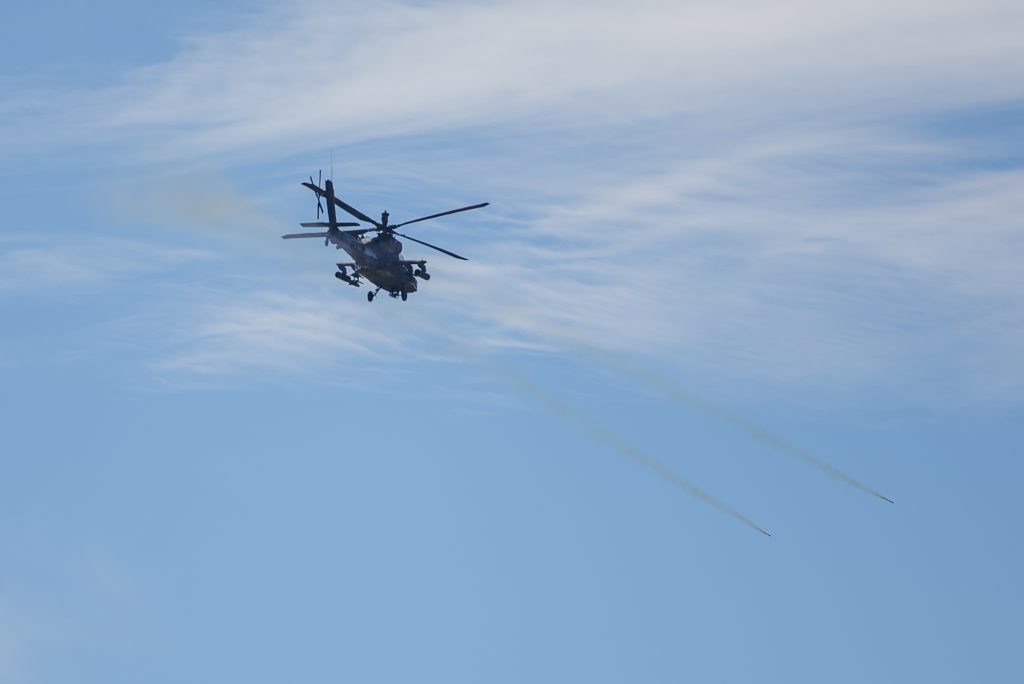
Washington’s Apaches, Soldiers assist Idaho in final testing for new range
By Master Sgt. Becky Vanshur/Idaho Military Division Public Affairs
The Idaho Army National Guard completed its Government Acceptance Test on its newest range, March 5-11, at the Orchard Combat Training Center. The Digital Air Ground Integration Range needed the aircraft portion of the GAT to become fully qualified. Previous components of the test were completed last spring with Abrams tanks, Bradley Fighting Vehicles and Strykers.
“It’s very exciting to complete the last element of certifying the OCTC’s DAGIR,” said Brig. Gen. Farin Schwartz, commander of the Idaho Army National Guard. “The exceptional capability of this valuable training resource is available to enhance combat readiness to crew members of all weapon systems, including pilots who train on this range.”
The U.S. Army’s 1st of the 229th Attack Reconnaissance Battalion pilots and crew members from Joint Base Lewis-McChord, Washington, conducted crew qualification using their AH- 64 Apache helicopters on the DAGIR throughout the week.
Construction on the DAGIR was completed last year, making it the only National Guard ran DAGIR range and only one of two such ranges across the U.S. Army. The range allows air and ground units to train together while receiving accurate and real-time feedback on their performance.
Although aviation units have used the range since its opening, last week was the first time range officers were able to schedule an aviation unit that met the correct requirements to conduct the GAT.
Special electronic equipment is placed on vehicles or aircraft to collect data. That data is sent back to the range tower and compiled into useful information for the after action review of each vehicle or aircraft that uses the range. The 1st of the 229th Attack Reconnaissance Battalion tested its Aerial Weapons Scoring System using 30 mm rounds of M789 High Explosive Dual Purpose ammunition and 2.75-inch Hydra-70 rockets.
Manned and unmanned aviation crews; armor, Stryker and infantry crews; and other sections and platoons can conduct combined arms live-fire exercises together on the range using 200 different targets that provide more than 400 possible training scenarios.
The DAGIR is the primary qualification range for AH-64 Apaches and an approved alternate range for tanks and Bradley Fighting Vehicles. The range can simulate multiple vehicles working together with air support, as well as unmanned aerial vehicles providing over watch.
A conex village on the range provides units the opportunity to train on dismounted operations and to incorporate Marines and Air Force joint terminal attack controllers on the ground into the training scenario.
“The DAGIR is a great asset to the OCTC and the units that train here,” said Capt. Jeff Dahl, OCTC Range Officer. “The range compiles information from the vehicle and crew during their gunnery and provides additional feedback to the units to better train crews and help build platform proficiency. Having the DAGIR added to the existing OCTC facilities is a huge benefit and we hope it continues to attract units to come train in Idaho.”
The Idaho National Guard’s OCTC is located 19 miles south of Boise. Its 143,000 acres and 23 training ranges provide vast terrain to facilitate world-class training to prepare brigade combat teams and other units for combat through a tough and realistic training environment.
 Official Government Website
Official Government Website